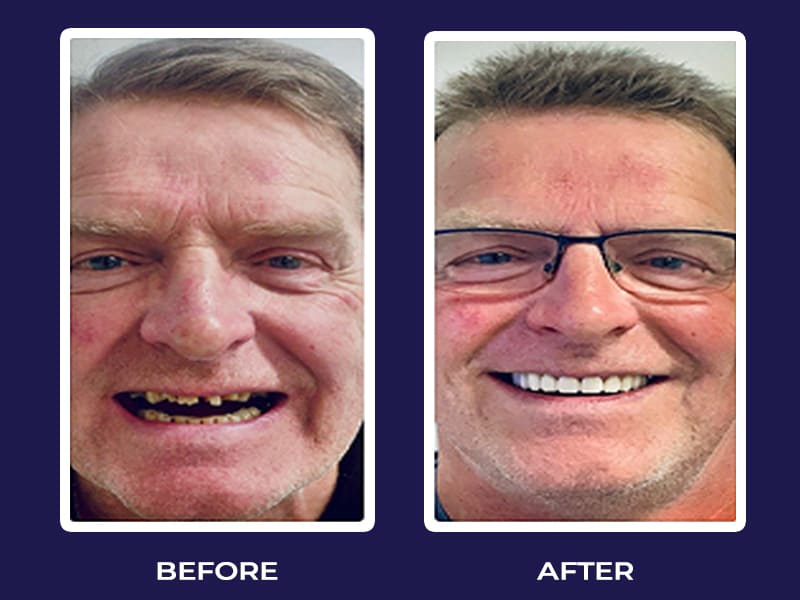
How to deal with a broken tooth.
March 19, 2023
Is it ok to leave a cracked tooth? While many people do leave a cracked or broken
tooth, the answer is no! If you have a broken tooth, it’s important to seek dental care as
soon as possible, because if you’re wondering, can a cracked tooth recover? The answer is
not without support from a dentist. Although, you should not attempt to fix for your broken or
cracked tooth, here are some steps you can take in the meantime:


1. Rinse your mouth with warm water to clean the area around the broken tooth.
2. Apply a cold compress to the outside of your cheek to reduce swelling.
3. If you have pain, take over-the-counter pain medication as directed. Broken teeth can
be painful as they can leave the pulp of the tooth, which is the centre of the tooth
containing the nerves, exposed.
4. If you have a jagged or sharp edge on the broken tooth, cover it with a piece of
sugarless gum or wax paraffin to protect your tongue and cheek until you can see a
dentist. It’s important to remember that this should only be used as a temporary fix
and not overnight.
How to Deal with a Broken Tooth
Introduction
Dealing with a broken tooth can be a painful and stressful experience. Whether it’s a minor chip or a severe fracture, it’s essential to know how to respond promptly to alleviate discomfort and prevent further damage. In this guide, we’ll discuss the steps to take when faced with a broken tooth, from immediate first aid to long-term solutions.
1. Assess the Damage:
The first step in dealing with a broken tooth is to assess the extent of the damage. A broken tooth can be classified into different categories, including:
Chipped tooth: A small piece of the tooth enamel is broken.
Cracked tooth: A fracture line extends through the tooth but does not split it into two.
Broken cusp: A part of the tooth’s chewing surface (the pointed part) is damaged.
Split tooth: The tooth is split into two or more pieces.
Vertical root fracture: A crack extends from the root upward.
The type of break will influence the treatment approach, so understanding the damage is crucial.
2. First Aid:
Immediate first aid can help alleviate pain and protect the tooth until you can see a dentist. Here’s what you should do:
Rinse your mouth with warm water to clean the area.
If there’s bleeding, apply gentle pressure with gauze.
If the tooth has chipped or a piece has come off, try to save it. You can place it in milk or a tooth preservation kit.
Over-the-counter pain relievers can help with discomfort.
3. Contact a Dentist:
It’s essential to consult a dentist as soon as possible, even if the break seems minor. The dentist will evaluate the damage and recommend the most appropriate treatment.
4. Temporary Solutions:
In some cases, the dentist may provide a temporary solution, such as dental bonding or a dental crown, until a permanent solution can be implemented.
5. Long-Term Solutions:
Long-term solutions for a broken tooth may include:
Dental crowns: A cap placed over the damaged tooth to restore its shape and strength.
Dental veneers: Thin shells of porcelain or resin that cover the front surface of the tooth.
Dental implants: A permanent solution for severely damaged or missing teeth.
Root canal therapy: If the pulp of the tooth is affected, a root canal may be necessary to save the tooth.
Tooth extraction: In some cases, the tooth may need to be removed.
6. Prevention:
To prevent broken teeth in the future, consider these tips:
Avoid biting or chewing on hard objects.
Use a mouthguard during sports and activities with a risk of dental injury.
Maintain good oral hygiene to strengthen teeth.
The good news is that repairing a broken tooth is fairly straightforward, falling under
general dentistry meaning your family dentist can usually fix your tooth without
referral. While the cost of fixing a broken tooth may vary depending on what
treatment is used, it can be covered under both private and NHS treatment.
If you have a tooth that has been completely knocked out, try to put it back in place if
possible. Rinse the tooth off gently with water, and try to place it back in the socket. If you
can’t get the tooth to stay in the socket, put it in a cup of milk or saliva to keep it moist as
your dentist may be able to save your tooth! Call your dentist as soon as possible to make
an appointment.
It’s important to see a dentist as soon as possible because a broken tooth can lead to more
serious problems if left untreated. A broken tooth can leave nerves within the tooth exposed
which may lead to infection or severe sensitivity. While many people like to procrastinate and
ignore a broken tooth, this can lead to more lengthy treatments being required, which are
often more costly. The dentist will examine the tooth and determine the best course of
treatment, which may include filling the tooth, placing a crown, or extracting the tooth. Most
dentists opt to avoid removing teeth when possible, to leave you with as many of your
natural teeth as possible.
Want to discuss your general dentistry needs? Why not get in touch with one of our
recommended dentists today!
Here Are Some Relevant Pieces You Can Read About Teeth Shaping
If you are interested in Broken tooth in Poole, Andover Hampshire & Southampton, Sandbanks UK, Contact us or Book an Appointment.

 Head Office - UK - Unit 1 B 132 Weyhill Road, Andover, Hampshire England, SP10 2PR.
Head Office - UK - Unit 1 B 132 Weyhill Road, Andover, Hampshire England, SP10 2PR. 









